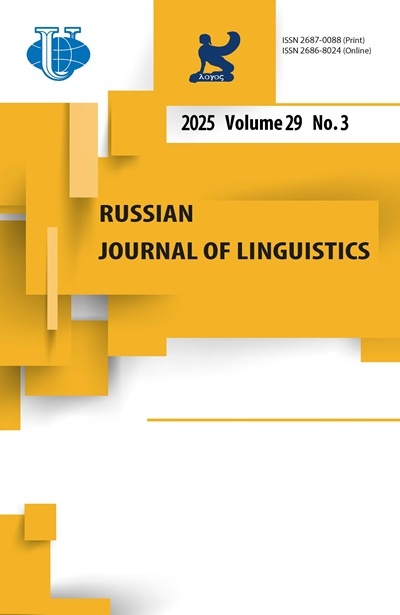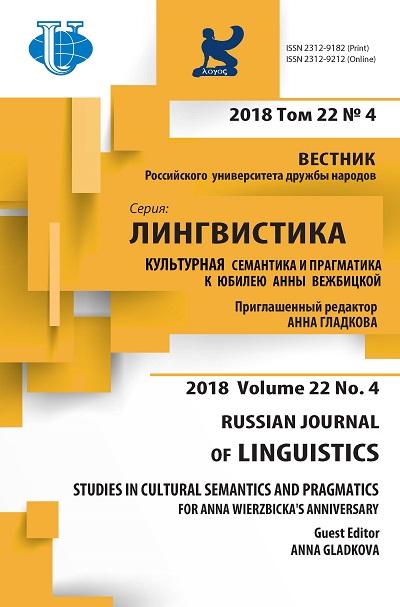Алгоритмы построения комических текстов
- Авторы: Карасик В.И.1,2
-
Учреждения:
- Государственный институт русского языка имени А.С. Пушкина
- Тяньцзиньский университет иностранных языков
- Выпуск: Том 22, № 4 (2018): Культурная семантика и прагматика: к юбилею Анны Вежбицкой
- Страницы: 895-918
- Раздел: КУЛЬТУРНАЯ СЕМАНТИКА И ПРАГМАТИКА
- URL: https://journals.rudn.ru/linguistics/article/view/20174
- DOI: https://doi.org/10.22363/2312-9182-2018-22-4-895-918
- ID: 20174
Цитировать
Полный текст
Аннотация
Цель данной статьи состоит в рассмотрении семиотических характеристик интерпретации комических текстов, в обсуждении семантических, прагматических и синтактических признаков таких вербальных образований. Юмористическое общение становится возможным, если актуализируются три условия: 1) коммуникативное намерение участников общения уйти от серьезного разговора, 2) юмористическая тональность общения, т.е. стремление сократить дистанцию и критически переосмыслить в мягкой форме актуальные концепты, 3) наличие определенных моделей смехового поведения, принятого в данной лингвокультуре. Для выявления таких моделей - алгоритмов построения комических текстов - были проанализированы размещенные в интернете шутки разных типов на русском языке (около 1000 анекдотов, шутливых афоризмов, демотиваторов). Семантические механизмы образования комического текста проявляются в карикатурной презентации предметов, пространственных и временных координат, позиций персонажей и осмысливаются как смешная двусмысленность высказывания, имеющая денотативное и сигнификативное измерения. Прагматические механизмы построения подобных комических текстов - это оценочные и выводные несоответствия между положениями дел, эти несоответствия представляют собой столкновения несовместимых сценариев интерпретации. Синтактический аспект комических текстов представляет собой их соотнесенность с определенными повествовательными, описательными и аргументативными жанрами речи. Выделено две модели алгоритмов создания и понимания комических текстов: совмещение линий реальности и совмещение линий сообщения о реальности, представляющих собой диктальное и модусное осмысление факта, вызывающего улыбку или смех. Диктальная модель включает комическое повторение, комическое противопоставление и комическое переворачивание позиций персонажей. Модусная модель прослеживается в шутливых перифразах, пародировании прецедентных текстов и комических аллюзиях. В современной коммуникативной практике часто используются шутливые высказывания с целью самопрезентации. Для таких комических текстов характерны аллюзии и различные виды интертекстуальных связей, построенные на рассогласовании между темой и ремой, текстуальным и иконическим содержанием сообщения.
Ключевые слова
Об авторах
Владимир Ильич Карасик
Государственный институт русского языка имени А.С. Пушкина; Тяньцзиньский университет иностранных языков
Email: vkarasik@yandex.ru
доктор филологических наук, профессор кафедры общего и русского языкознания Государственного института русского языка имени А.С. Пушкина / профессор Тяньцзиньского университета иностранных языков ул. Академика Волкова, д. 6, Москва, Россия, 117485; ул. Мачандао, д. 117, Тяньцзинь, Китай, 300204
Список литературы
- Аттардо С. Миф о непреднамеренном юморе // Аксиологическая лингвистика: игровое и коми¬ческое в общении: сб. науч. тр. / под ред. В.И. Карасика, Г.Г. Слышкина. Волгоград: Перемена, 2003. С. 4-14. [Attardo S. (2003). The myth of unintended hu-mor. In V.I. Karasik, G.G. Slyshkin (eds.) Axiological Lin-guistics: ludic and comic in communication: collection of ar-ticles. Volgograd: Peremena, 4-14. (In Russ.)]
- Белл Р. Социолингвистика. М.: Междунар. отношения, 1980. 320 с. [Bell R. (1980). Socio¬lingustics. Moscow: Mezhdunarodnye otnoshenia. (In Russ.)]
- Бергсон А. Смех. М.: Искусство, 1992. 127 с. [Bergson H. (1992). Laughter. Moscow: Iskusstvo. (In Russ.)]
- Вежбицкая А. Язык. Культура. Познание: Пер. с англ. М.: Русские словари, 1996. 416 с. [Wierzbicka A. (1996). Language. Culture. Cognition. Moscow: Russian Dictionaries. (In Russ.)]
- Вежбицка А. Речевые жанры // Жанры речи. Саратов: Колледж, 1997. С. 99-111. [Wierz¬bicka A. (1997). Speech genres. Speech genres, 99-111. (In Russ.)]
- Вежбицкая А. Семантические универсалии и описание языков. М.: Школа «Языки русской культуры», 1999. 780 с. [Wierzbicka A. (1999). Semantic universals and language description. Moscow: School “Russian Culture Languages”. (In Russ.)]
- Габидуллина А.Р. Анекдот с точки зрения прагмалингвистики // Восточноукраинский лингви¬стический сборник. Вып. 6. Донецк: Донеччина, 2000. C. 295-302. [Gabidullina A.R. (2000). Anecdote from pragmalinguistic point of view. East Ukrainian Linguistic Collection of articles. 6, 295-302. (In Russ.)]
- Голиков А.С., Калашникова А.А. Демотиваторы в интернет-коммуникации: генезис, смыслы, типология // Вестник Харьковского государственного университета. 2010. Вып. 16. С. 124-130. [Golikov A.S., Kalashnikova A.A. (2010). Demotivators in internet communica¬tion: genesis, meanings, typology. Khar-kov State University Journal. 16, 124-130. (In Russ.)]
- Горностаева А.А. Место иронии в речевых портретах современных политических деятелей // Вестник Российского университета дружбы народов. Серия: Лингвистика. 2016. № 1. С. 57-76. [Gor-nostaeva A.A. (2016). Irony in speech portraits of modern pol-iticians. Russian Journal of Linguistics. 1, 57-76. (in Russ.)]
- Горностаева А.А. Иронические метафоры в политическом дискурсе // Вестник Российского университета дружбы народов. Серия: Лингвистика. 2018. № 1. С.108-125. [Gorno¬staeva A. (2018). Ironic Metaphors in Political Discourse. Russian Journal of Linguistics, 22 (1), 108-125. doi: 10.22363/2312-9182-2018-22-1-108-125. (In Russ.)]
- Гришаева Л.И. Анекдот как способ фиксации социальных норм и морально-этических ценно¬стей социума // Вопросы филологии и методики преподавания иностранных языков. Омск: Изд-во Ом. гос. ун-та, 1998. С. 107-118. Grishaeva L.I. (1998). Anecdote as means of social norms and moral values fixation. In: Prob-lems of Philology and Foreign Languages Teaching Methods. Omsk: Omsk University Publishers, 107-118. (In Russ.)]
- Дмитриев А.В. Социология юмора: Очерки / Отд. филос., социол., психол. и права РАН. М., 1996. 214 с. [Dmitriev A.V. (1996). Sociology of Humour: Essays. Moscow: Russian Academy of Sciences, Dept. of Sociology, Psychology and Law. (In Russ.)]
- Еленевская М. Двуязычный юмор иммигрантов: языковая игра и социальная адаптация (на примере смеховой культуры русскоязычных израильтян) // Вестник Российского университета дружбы народов. Серия Лингвистика. 2014. № 3. С. 7-27. [Elenevskaya M. (2014). Bilingual humour of immigrants: lan-guage play and social adaptation (the case of ludic culture of Russian speaking Israelis). Russian Journal of Linguistic, 3, 7-27. (In Russ.)]
- Козинцев А.Г. Человек и смех. СПб.: Алетейя, 2007. 236 с. [Kozintsev A.G. (2007). Man and laughter. Saint-Petersburg: Aleteya. (In Russ.)]
- Кулинич М.А. Лингвокультурология юмора (на материале английского языка): монография. Самара: Изд-во Самарск. гос. пед. ун-та, 2004. 264 с. [Kulinich M.A. (2004). Linguistic Culturology of Humour (on the material of English): monograph. Samara: Samara University Publishers. (In Russ.)]
- Курганов Е.Я. Анекдот как жанр. СПб.: Академический проект, 1997. 123 с. [Kurganov E.Ya. (1997). Anecdote as a genre. Saint-Petersburg: Academic project. (In Russ.)]
- Лутовинова О.В. Демотиватор как вид сетевого творчества // Вестник Волгоградского государ¬ственного университета. Серия «Языкознание». 2016. № 3. Т. 15. С. 28-36. [Lutovi¬nova O.V. (2016). Demotivator as a kind of network creativity. Volgograd University Journal, Vol. 15. 3, 28-36. (In Russ.)]
- Месропова О.М. Прагмасемантическая классификация текстов шуток и анекдотов // Языковая система и социокультурный контекст. СПб., 1997. С. 166-168. [Mesropova O.M. (1997). Pragmasemantic classification of jokes and anecdotes. Language system and sociocultural context. Saint-Petersburg, 166-168. (In Russ.)]
- Минский М. Остроумие и логика коллективного бессознательного // Новое в зарубежной лингвистике. Вып. XXIII. Когнитивные аспекты языка. М.: Прогресс, 1988. С. 281-309. [Minsky M. (1988). Jokes and the logic of cognitive unconscious. Modern Linguistics Abroad. Vol. 23. Cognitive aspects of language. Moscow: Progress Publishers, 281-309. (In Russ.)]
- Моррис Ч.У. Основания теории знаков // Семиотика: Антология / Сост. Ю.С. Степанов. М.: Акад. проект, 2001. С. 45-97. [Morris Ch. (2001). Semiotic Theory Foundations. Semiotic: Anthology. Ed. By Yu.S. Stepanov. Moscow: Academic Project, 45-97. (In Russ.)]
- Мышкина Н.Л. Динамико-системное исследование смысла текста. Красноярск: Изд-во Крас¬нояр. ун-та, 1991. 212 с. [Myshkina N.L. (1991). Dynamic and systemic investigation of text meaning. Krasnoyarsk: Krasnoyarsk University Publishers. (In Russ.)]
- Норман Б.Ю. К анализу анекдота как жанра непрямой коммуникации // Прямая и непрямая коммуникация: сб. науч. ст. Саратов: Колледж, 2003. С. 283-290. [Norman B.U. (2003). On anecdote as a genre of indirect communication analysis. Direct and indirect communication: collection of articles. Saratov: College, 283-290. (In Russ.)]
- Плотникова С.Н. Комический дискурс // Аксиологическая лингвистика: игровое и комическое в общении: сб. науч. тр. / под ред. В.И. Карасика, Г.Г. Слышкина. Волгоград: Перемена, 2003. С. 162-172. [Plotnikova S.N. (2003). Comic discourse. Axiological Linguistics: ludic and comic in communication: collection of articles. Ed. by V.I. Karasik, G.G. Slyshkin. Volgograd: Peremena, 162-172. (In Russ.)]
- Пропп В.Я. Проблемы комизма и смеха. Ритуальный смех в фольклоре (по поводу сказки о Несмеяне). М.: Лабиринт, 1999. 256 с. [Propp V.Ya. (1999). Problems of comism and laughter. Ritual laughter in folklore (about the fairy tale Nesmeyana). Moscow: Labyrinth. (In Russ.)]
- Шмелева Е.Я., Шмелев А.Д. Рассказывание анекдота как жанр современной русской речи: проблемы вариативности // Жанры речи: Сб. науч. ст. Саратов: Колледж, 1999. С. 133-145. [Shmeleva E.Ya., Shmelev A.D. (1999). Anecdote presentation as a modern Russian speech genre: problems of variation. Speech Genres: Collection of articles. Saratov: College, 133-145. (In Russ.)]
- Щурина Ю.В. Классификация комических речевых жанров коммуникативного пространства Интернета // Известия Волгоградского государственного педагогического университета. 2014. № 2. С.39-43. [Schurina Yu.V. (2014). Comic speech gen-res classification in the In¬ternet communicative space. Volgo-grad State Pedagogical University Journal. 2, 39-43. (In Russ.)]
- Alba-Juez L. (2014). Irony as Inferred Contradiction. Russian Journal of Linguistics. 4, 140-153.
- Alba-Juez L., Attardo S. (2014). The evaluative palette of verbal irony. In L. Alba-Juez & G. Thomp¬son (eds.) Evaluation in Context. Amsterdam: John Benjamins. 2014.
- Alba-Juez L., Larina T. (2018). Language and Emotion: Discourse-Pragmatic Perspectives. Russian Journal of Linguistics. 2018. 22 (1), 9-37.
- Attardo S. (1994). Linguistic Theories of Humor. Berlin; N.Y.: Mouton de Gruyter.
- Attardo S. (2001). Humorous Texts: A semantic and pragmatic analysis. Berlin: Mouton de Gruyter, 2001.
- Chiaro D. (1992). The Language of Jokes: Analysing Verbal Play. London, N.Y.: Routleage.
- Dynel M. (2008). Introduction to special issue on humour: A modest attempt at presenting contempo¬rary linguistic approaches to humour studies. Lodz Papers in Pragmatics. 4 (1), 1-12.
- Gornostaeva A. (2016). American Political Discourse: Irony in Pre-Election Campaign 2016. Russian Journal of Linguistics, 20 (4), 179-196.
- Giora R. (1991). On the Cognitive Aspect of the Joke. Journal of Pragmatics. 16, 465-485.
- Goddard C. (2016). Ethnopragmatic perspectives on conversational humour, with special reference to Australian English. Language & Communication, 1-14.
- Goddard C. (2009). Not taking yourself too seriously in Australian English: Semantic explications, cultural scripts, corpus evidence. Intercultural Pragmatics. 6 (1), 29-53.
- Goddard C. (2006). Lift your game, Martina! - Deadpan jocular irony and the ethnopragmatics of Australian English. In C. Goddard (ed.). Ethnopragmatics: Understanding discourse in cultural context. Berlin: Mouton de Gruyter, 65-97.
- Haugh M. (2017a). Mockery and (non-)Seriousness in initial interactions amongst American and Australian speakers of English. In Donald Carbaugh (ed.). The Handbook of Communication in Cross-Cultural Perspective. New York, United States: Routledge, 104-117.
- Haugh M. (2017b). Jocular language play, social action and (dis)affiliation in conversational inter¬action. In Nancy Bell (ed.). Multiple perspectives on language play. Boston, MA, United States: De Gruyter Mouton, 143-168.
- Janes L.M., Olson J.M. (2015). Humor as an abrasive or a lubricant in social situations: Martineau revisited. Humor: International Journal of Humor Research. 28 (2), 271-288.
- Kotthof H. (2006). Pragmatics of performance and the analysis of conversational humor. Humor: International Journal of Humor Research. 19 (3), 271-304.
- Kuiper N.A., McHale N. (2009). Humor styles as mediators between self-evaluative standards and psychological well-being. Journal of Psychology: Interdisciplinary and Applied. 143 (4), 359-376.
- Kuiper N.A., Leite C. (2010). Personality impressions associated with four distinct humor styles. Scandinavian Journal of Psychology. 51, 115-122.
- Leech G.N. (1093). Principles of pragmatics. London: Longman.
- Raskin V. (1985). Semantic Mechanisms of Humor. Dordrecht: Reidel.
- Soussa A., Bazenga A., Antunes L. (2009). Cross-cultural humour: Humor that divides, humour that unites. An introduction. Journal of Linguistics and Intercultural Education, 2 (2), 9-11.
- Vandaele J. (2002). (Re-)Constructing Humour: Meaning and Means The Translator: Studies in Intercultural Communication. 8 (2), 149-172.
- Wierzbicka A. (2003). Cross-cultural Pragmatics: The Semantics of Human Interaction. New York, Berlin: Mouton de Gruyter.
- Yus F. (2018). Attaching feelings and emotions to prepositions. Some insights on irony in internet communication. Russian Journal of Linguistics. 1, 94-107.
Дополнительные файлы















